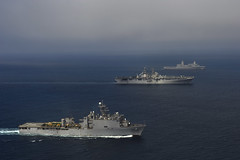 |
| USS Pearl Harbor (LSD 52) Foreground USS Makin Island (LHD 8) Middle USS New Orleans (LPD 18) Background (U.S. Navy photo by Chief Mass Communication Specialist John Lill - Released) |
From Expeditionary Strike Group Three Public Affairs
SAN DIEGO - The Makin Island Amphibious Ready Group (ARG) is scheduled to depart San Diego for deployment Nov. 14.
USS Makin Island (LHD 8), one of the Navy's newest, and most efficient amphibious assault ships, will make its maiden deployment as the flagship for Amphibious Squadron Five and the 11th Marine Expeditionary Unit (MEU). Makin Island is the first U.S. Navy ship to be equipped with gas turbines and an electric drive system, replacing the older technology of steam boilers. With the ship's electric drive running, which is similar in functionality to that of a hybrid car, it is possible to transit longer distances using less fuel.
Additionally, Makin Island is the first U.S. Navy ship to have an advanced electrical plant that powers all of the ship's auxiliaries, including the capability to produce 200,000 gallons of fresh water every day.
The Makin Island ARG, consisting of Makin Island, amphibious dock landing ship USS Pearl Harbor (LSD 52) and amphibious transport dock ship USS New Orleans (LPD 18) and embarked support units, is commanded by Capt. Humberto Quintanilla, Commander, Amphibious Squadron Five.
"Our Navy and Marine Corps team plays a critical role in facilitating international maritime security cooperation," said Quintanilla. "Global maritime security can only be achieved through the unity of international and regional maritime integration, awareness, and response initiatives. The safety and economic interests of the United States and our allies and partner nations depend on unimpeded trade across the world's oceans."
Over the next several months, the Makin Island ARG and 11th MEU will work together to support the Navy's Maritime Strategy abroad.
The Makin Island ARG helps provide deterrence, promote peace and security, preserve freedom of the sea and humanitarian/disaster response within Third Fleet's 50-million square mile area of responsibility in the Eastern Pacific, as well as supporting the Navy's Maritime Strategy when forward deployed.
USS Makin Island (LHD 8), one of the Navy's newest, and most efficient amphibious assault ships, will make its maiden deployment as the flagship for Amphibious Squadron Five and the 11th Marine Expeditionary Unit (MEU). Makin Island is the first U.S. Navy ship to be equipped with gas turbines and an electric drive system, replacing the older technology of steam boilers. With the ship's electric drive running, which is similar in functionality to that of a hybrid car, it is possible to transit longer distances using less fuel.
Additionally, Makin Island is the first U.S. Navy ship to have an advanced electrical plant that powers all of the ship's auxiliaries, including the capability to produce 200,000 gallons of fresh water every day.
The Makin Island ARG, consisting of Makin Island, amphibious dock landing ship USS Pearl Harbor (LSD 52) and amphibious transport dock ship USS New Orleans (LPD 18) and embarked support units, is commanded by Capt. Humberto Quintanilla, Commander, Amphibious Squadron Five.
"Our Navy and Marine Corps team plays a critical role in facilitating international maritime security cooperation," said Quintanilla. "Global maritime security can only be achieved through the unity of international and regional maritime integration, awareness, and response initiatives. The safety and economic interests of the United States and our allies and partner nations depend on unimpeded trade across the world's oceans."
Over the next several months, the Makin Island ARG and 11th MEU will work together to support the Navy's Maritime Strategy abroad.
The Makin Island ARG helps provide deterrence, promote peace and security, preserve freedom of the sea and humanitarian/disaster response within Third Fleet's 50-million square mile area of responsibility in the Eastern Pacific, as well as supporting the Navy's Maritime Strategy when forward deployed.
